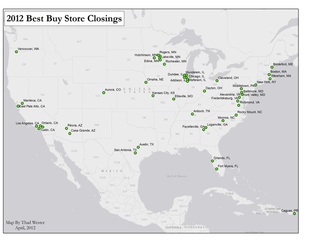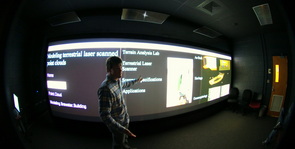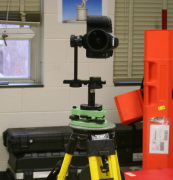
This is a map of the planned Best Buy store closings in 2012.
|
1 Comment
 I placed first in the RENCI Visualization Challenge held at East Carolina University on March, 29, 2011. Each participant was challenged to make the best use of the Vis-wall during a ten minute presentation to an audience of faculty and students. The Vis-wall provides a unique environment for displaying content and consists of a rear projected display at the resolution of 4200 x 1400. My presentation introduced terrestrial laser scanning to the audience and provided them with a visualization of the Brewster building. I chose the Brewster building since the contest was being held within the building. This allowed the audience a better conceptual environment from which to understand terrestrial laser scanning technology, whereas if I had chosen any other laser scanned dataset, the audience may not have completely comprehended the abilities and methods of laser scanning. As part of the presentation I made an animation fly-through of the Brewster building model and point cloud data at a widescreen resolution appropriate to the resolution and aspect ratio of the Vis-wall. I have uploaded the video below, however in a resolution and proportion which is easier to view at standard aspect ratios found on most PC's and laptops. I had written previously about the better image quality when using the Nodal Ninja setup, compared with the images of the built in web cam on the Leica C10. Below is a comparison, but before you examine the images let me make a few statements.
1) The imagery from the web cam in this instance I consider to be very good. 2) I took the scan images and the Nodal Ninja images on two separate days, so some stuff (chairs, bikes, book bags, etc...) changed position. This results in the images and point cloud not matching up perfectly for the nodal ninja example. 3) The resolution of the scan was 1cm at 10m 360x270.  Nodal Ninja setup Took out our Nodal Ninja setup out for our Leica C10 laser scanner today. If you don't know what a Nodal Ninja is, it is a bracketed camera mount that fits into a terrestrial laser scanner's tribrach. It provides a way of overlaying higher quality images onto scanned point clouds than are provided by the "web cam" like camera built into most laser scanners. The major advantage of the nodal ninja setup is that it enhances the color quality of the images and not so much that it adds resolution over the built in camera. The images look incredible with our Cannon 5D Mark II with Sigma 8mm f/3.5 fish eye lens attached to the Nodal Ninja. The unbelievable field of view of the fish eye lens and 5D's full frame sensor gives the panorama advantages over just about any other camera used with this setup, allowing for almost perfect coverage with only three pictures, and near perfect exposure without a flash in just about all lighting conditions. This makes the camera ideal for taking pictures outside and from multiple scanning locations over the course of a day, since the 5D will give similar pictures regardless of the amount of sunlight. I'm trying to get the work flow down for the Nodal Ninja so that we can use it next week on a scan project we have planned on the campus of East Carolina University. More to come soon... |
|